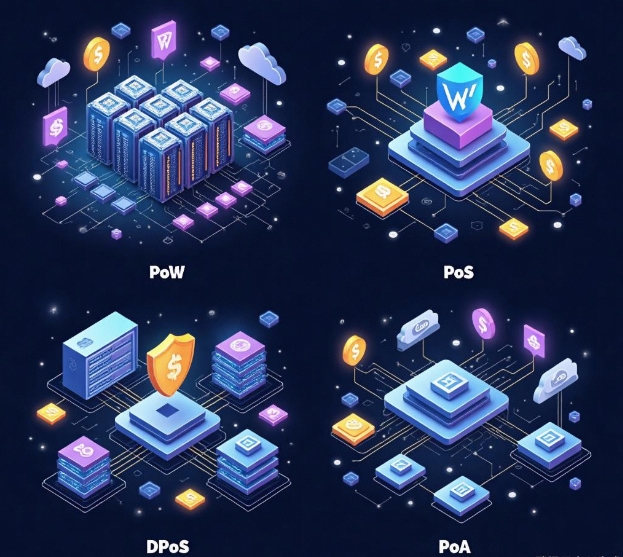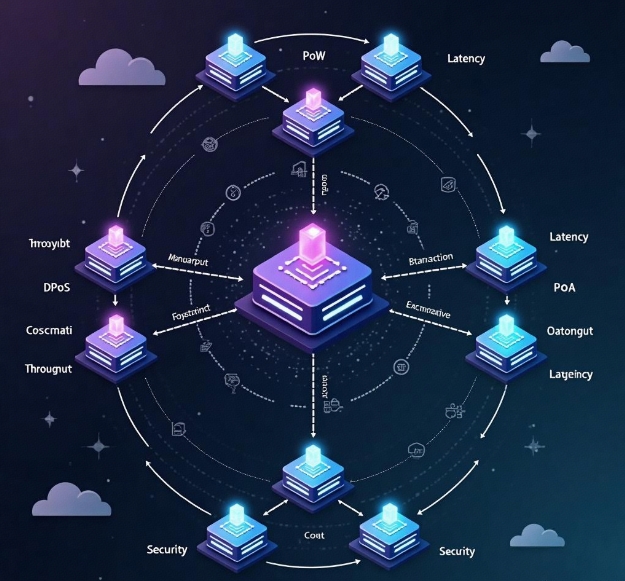DApp Development and Blockchain Consensus Mechanisms: How to Optimize Performance
- latest articles
- 1.DApp Development & Customization: Merging Diverse Market Needs with User Experience 2.Analysis of the Core Technical System in DApp Project Development 3.How to achieve cross-chain interoperability in Web3 projects? 4.How does the tokenization of points reconstruct the e-commerce ecosystem? 5.How to Set and Track Data Metrics for a Points Mall? 6.What is DApp Development? Core Concepts and Technical Analysis 7.Inventory of commonly used Web3 development tools and usage tips 8.Development of a Distribution System Integrated with Social E-commerce 9.Six Key Steps for Businesses to Build a Points Mall System 10.What is DApp Development? A Comprehensive Guide from Concept to Implementation
- Popular Articles
- 1.Future Trends and Technology Predictions for APP Development in 2025 2.Analysis of the DeFi Ecosystem: How Developers Can Participate in Decentralized Finance Innovation 3.From Zero to One: How PI Mall Revolutionizes the Traditional E-commerce Model 4.DAPP Development | Best Practices for Professional Customization and Rapid Launch 5.Recommended by the Web3 developer community: the most noteworthy forums and resources 6.From Cloud Computing to Computing Power Leasing: Building a Flexible and Scalable Computing Resource Platform 7.How to Develop a Successful Douyin Mini Program: Technical Architecture and Best Practices 8.Shared Bike System APP: The Convenient Choice in the Era of Smart Travel 9.How to Create a Successful Dating App: From Needs Analysis to User Experience Design 10.From Design to Development: The Complete Process of Bringing an APP Idea to Life
With the rapid development of blockchain technology, decentralized applications (DApps) are gradually becoming popular solutions in various fields such as technology, finance, and social networking. DApps leverage blockchain characteristics like decentralization, security, and transparency to provide innovative services to users. However, performance optimization of DApps has always been a significant challenge for developers, especially concerning the blockchain's consensus mechanism. This article will explore how to utilize blockchain consensus mechanisms to optimize performance in DApp development and analyze the advantages and disadvantages of different consensus mechanisms.
I. The Relationship Between DApps and Blockchain Consensus Mechanisms
DApps (Decentralized Applications) refer to applications developed based on blockchain technology. These applications do not rely on traditional centralized servers but operate and store data through nodes in the blockchain network. The core advantages of DApps lie in their characteristics of decentralization, transparency, immutability, and self-governance, all of which stem from the design philosophy of blockchain.
The blockchain itself consists of multiple nodes, each holding a copy of the ledger and reaching consensus through a consensus mechanism to ensure data consistency and security. The consensus mechanism is the core of blockchain technology, determining how nodes agree on the order and legitimacy of transactions and the updating of the ledger.
In the DApp development process, the choice of consensus mechanism directly impacts the application's performance, scalability, and security. Therefore, optimizing the consensus mechanism is not only key to enhancing DApp performance but also an important direction for the development of blockchain technology.
II. Common Blockchain Consensus Mechanisms
When exploring how to optimize DApp performance, it is first necessary to understand several common blockchain consensus mechanisms. Different consensus mechanisms are suitable for different application scenarios, and their impact on performance varies.
1. Proof of Work (PoW)
Proof of Work (PoW) is the consensus mechanism adopted by blockchain networks such as Bitcoin and Ethereum. In PoW, nodes compete for the right to record transactions by solving complex mathematical problems. The first node to solve the problem can add a new block to the blockchain and receive a certain reward.
The advantage of PoW is its extremely high security; due to the need to consume significant computational resources and electricity, it is difficult for attackers to tamper with data. However, the drawbacks of PoW are also very apparent—high energy consumption and inefficient transaction processing capability. This means that DApps using the PoW consensus mechanism may face performance bottlenecks, especially in high-frequency trading or applications requiring rapid responses.
2. Proof of Stake (PoS)
Proof of Stake (PoS) is another common consensus mechanism. In PoS, nodes obtain the right to record transactions by holding and staking a certain amount of tokens. The more tokens held, the higher the probability of obtaining the right to record. Unlike PoW, PoS does not require extensive computational resources, resulting in higher energy efficiency and transaction throughput.
The advantages of the PoS mechanism include low energy consumption and fast transaction processing speed, making it particularly suitable for high-frequency trading and DApps requiring quick responses. However, PoS also carries a certain risk of centralization, as nodes holding large amounts of tokens are more likely to become recording nodes.
3. Delegated Proof of Stake (DPoS)
Delegated Proof of Stake (DPoS) is a variant of PoS. In DPoS, token holders vote to elect a small number of representative nodes responsible for maintaining the blockchain's transaction recording. This mechanism improves transaction processing speed by reducing the number of nodes participating in consensus, making it suitable for DApps requiring high scalability.
The advantages of DPoS include high transaction throughput and low latency, making it suitable for large-scale decentralized applications. However, since a small number of nodes hold significant control, DPoS may lead to certain centralization issues.
4. Proof of Authority (PoA)
Proof of Authority (PoA) is a consensus mechanism that operates through identity verification. In PoA, only a few authorized nodes can record transactions and validate them. The advantage of PoA is its very fast transaction confirmation speed, making it suitable for enterprise-level applications and private chains. The drawback is its high degree of centralization, which may sacrifice the benefits of decentralization.
III. Key Factors for DApp Performance Optimization
DApp performance optimization involves multiple aspects, including transaction throughput, latency, cost, security, and user experience. By analyzing different consensus mechanisms, we can propose the following key directions for performance optimization:
1. Increase Transaction Throughput
The transaction throughput of a blockchain network is an important metric for measuring its performance. A blockchain with high transaction throughput can process more transactions in a short period, which is crucial for the responsiveness and smoothness of DApps. Optimizing the consensus mechanism can directly increase transaction throughput.
For example, blockchains using PoS or DPoS consensus mechanisms can reach consensus and process more transactions faster compared to PoW. Under the PoS mechanism, due to the reduced competition among miners, transaction confirmation times are shorter, thereby improving overall throughput.
2. Reduce Transaction Latency
Transaction latency refers to the time from when a user submits a transaction request until the transaction is confirmed by the blockchain network. In DApps, transaction latency directly affects the user experience, especially in applications requiring real-time feedback such as finance and gaming, where high latency can lead to user churn.
To reduce transaction latency, DApp developers can consider adopting low-latency consensus mechanisms such as DPoS or PoA. Due to the smaller number of recording nodes in these consensus mechanisms, transaction confirmation is faster, effectively reducing latency.
3. Control Transaction Costs
The cost of blockchain transactions mainly comes from rewards for miners or validating nodes. Under PoW and PoS mechanisms, nodes need to consume certain computational resources or tokens to participate in recording, which leads to increased transaction fees.
To optimize transaction costs, DApps can consider choosing blockchain platforms with low transaction fees, such as those using DPoS or PoA. By reducing the resources required for transaction validation, DApps can effectively lower transaction costs and improve the user experience.
4. Enhance Security
Security is one of the most basic requirements for DApps, especially in sensitive fields such as finance, healthcare, and supply chain. The security of the consensus mechanism directly affects the blockchain network's resistance to attacks. For example, PoW, due to its high computational requirements and decentralized nature, offers high security. While PoS and DPoS can provide high transaction throughput, they may face issues like "the rich get richer" in certain situations, leading to security risks.
To ensure the security of DApps, developers need to choose the appropriate consensus mechanism based on specific requirements. For applications requiring high security, PoW or improved versions of PoS may be better choices.
5. Strengthen Decentralization Characteristics
Decentralization is one of the most important characteristics of blockchain. The higher the degree of decentralization in a DApp, the stronger its resistance to censorship and attacks. However, certain consensus mechanisms (such as DPoS and PoA) may lead to a certain degree of centralization due to the small number of nodes. To optimize the decentralization characteristics of DApps, developers need to balance the relationship between decentralization and performance.
IV. Consensus Mechanism Selection Strategies in DApp Development
In the DApp development process, the selection of a consensus mechanism should be comprehensively considered based on specific business needs and technical requirements. The following are several common selection strategies:
For high-frequency trading and real-time applications: Prioritize PoS, DPoS, or PoA mechanisms with faster transaction confirmation speeds. These mechanisms can increase transaction throughput and reduce latency, making them suitable for application scenarios requiring rapid responses.
For applications with high security requirements: For DApps in fields such as finance and healthcare, choose PoW or improved PoS mechanisms to ensure data security and integrity.
For applications requiring high decentralization: If decentralization is the core value of the DApp, choose PoW or more decentralized PoS mechanisms to ensure the network's decentralization characteristics.
For enterprise-level applications: Choose highly centralized consensus mechanisms like PoA to ensure optimal transaction processing speed and cost.
V. Summary
In the DApp development process, the selection and optimization of blockchain consensus mechanisms are crucial. Different consensus mechanisms have different advantages and disadvantages. DApp developers need to choose the appropriate consensus mechanism based on the application's characteristics and requirements and perform corresponding performance optimizations. By increasing transaction throughput, reducing transaction latency, controlling transaction costs, enhancing security, and optimizing decentralization characteristics, the overall performance of DApps can be significantly improved. As blockchain technology continues to develop, new consensus mechanisms and optimization strategies will continue to emerge, providing more possibilities for enhancing DApp performance.
-

DApp Development & Customization: Merging Diverse Market Needs with User Experience
As blockchain technology matures and becomes more widespread, decentralized appl···
-

Analysis of the Core Technical System in DApp Project Development
With the rapid development of blockchain technology, decentralized applications ···
-

What is DApp Development? Core Concepts and Technical Analysis
With the rapid development of blockchain technology, decentralized applications ···

 Blockchain
Blockchain












